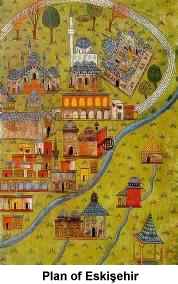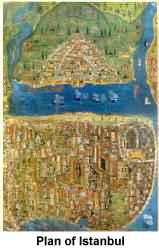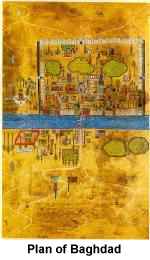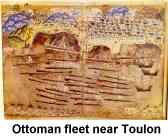MATRAKÇI NASUH
 The 16th century was the time of greatest for the Ottoman
Empire, and is regarded to by historians today as the classical age. The long reign of Sultan Süleyman the Magnificent from 1520 to 1566 set its mark
on this century, which was one of innovation in many fields of culture and science. One of
the great figures of the century was Matrakçı Nasuh, a man who excelled as
historian and soldier, calligrapher and painter. He was born in Bosnia towards the end of
the 15th century of a Christian family, and as a young boy became a janissary
novice under the tribute system. His ability attracted attention and he was educated at
the palace Enderun school during the last years of the reign of Sultan Bayezid II
(1481-1512). The 16th century was the time of greatest for the Ottoman
Empire, and is regarded to by historians today as the classical age. The long reign of Sultan Süleyman the Magnificent from 1520 to 1566 set its mark
on this century, which was one of innovation in many fields of culture and science. One of
the great figures of the century was Matrakçı Nasuh, a man who excelled as
historian and soldier, calligrapher and painter. He was born in Bosnia towards the end of
the 15th century of a Christian family, and as a young boy became a janissary
novice under the tribute system. His ability attracted attention and he was educated at
the palace Enderun school during the last years of the reign of Sultan Bayezid II
(1481-1512).
Matrakçı Nasuhs first known work is a book on mathematics which he wrote for
Sultan Bayezids successor Sultan Selim I (1512-1520) in 1517. Entitled Cemâlul-Küttab
ve Kemâlü-l-Hissâb, it covers fractions, measurements and other basic mathematics.
In 1533 Nasuh wrote an expanded version of this book entitled Umdetul Hissâb
and presented it to Sultan Süleyman the Magnificent.
 From
1517 onwards, Nasuh began to make a name for himself for his skill in the arts of combat,
as noted by such famous Ottoman writers as Aşık Çelebi, Celaloğlu Mustafa Ali. His
fame reached a pinnacle with his invention of a sport played with heavy boxwood cudgels
known as matrak. Two competition facing one another used 160 different movements of
defense and attack, the object being to strike the opponent on the head. From
1517 onwards, Nasuh began to make a name for himself for his skill in the arts of combat,
as noted by such famous Ottoman writers as Aşık Çelebi, Celaloğlu Mustafa Ali. His
fame reached a pinnacle with his invention of a sport played with heavy boxwood cudgels
known as matrak. Two competition facing one another used 160 different movements of
defense and attack, the object being to strike the opponent on the head.
As both the inventor and a champion of this sport, he became known as Matrakçı. His
mastery of the martial arts was acknowledged in a testimonial presented to him by Sultan
Süleyman I in 1529, with particular reference to his skill at javelin throwing, and
commanding all to pay him respect as a master in these fields. The same year he wrote a
book, Tuhfetul Guzaf, on archery, sword fighting and use of the shield fighting
with mace and lance, and training for combat on horseback. This is the only contemporary
book treating these subjects.
 But
Matrakçı Nasuh most celebrated work is book of plans and descriptions of the places
where the Ottoman army halted during Sultan Süleymans campaign against the Safavids in
1533-1536. Beyan-ı Menazil-i Sefer-i Irakeyn-i Sultan Süleyman Han consists of
113 pages of text, 25 illustrated, and 107 full page miniatures. The miniatures
illustrating the towns and cities on the armys way eastwards form a remarkable atlas of
the region. Castles, mosques, hans (khans), colleges and pavilions are shown in meticulous
detail, together with their surrounding terrain. The text gives the names and locations of
ruins, kervansarays (caravanserais), mountains, passers, rivers and bridges, deserts and
steppe, distances between each stopping point, and descriptions of local climate. The
miniatures are illustrations rather than maps and do not obey cartographic principles of
direction or scale, although when interpreted in the light of the text they provide much
of the information given by topographical maps. They could be described as a collection of
town plans, which take a birds eye view of each place, but instead of showing only
streets and rivers, have tiny detailed illustrations of the main buildings, monuments and
natural features. In this respect they are extremely valuable records of 16th
century Turkish architecture and urban structure. Conceptually they compare to the sea
charts of Piri Reis, which show the rocks, landmarks and
harbours of the Mediterranean in similar detail. But
Matrakçı Nasuh most celebrated work is book of plans and descriptions of the places
where the Ottoman army halted during Sultan Süleymans campaign against the Safavids in
1533-1536. Beyan-ı Menazil-i Sefer-i Irakeyn-i Sultan Süleyman Han consists of
113 pages of text, 25 illustrated, and 107 full page miniatures. The miniatures
illustrating the towns and cities on the armys way eastwards form a remarkable atlas of
the region. Castles, mosques, hans (khans), colleges and pavilions are shown in meticulous
detail, together with their surrounding terrain. The text gives the names and locations of
ruins, kervansarays (caravanserais), mountains, passers, rivers and bridges, deserts and
steppe, distances between each stopping point, and descriptions of local climate. The
miniatures are illustrations rather than maps and do not obey cartographic principles of
direction or scale, although when interpreted in the light of the text they provide much
of the information given by topographical maps. They could be described as a collection of
town plans, which take a birds eye view of each place, but instead of showing only
streets and rivers, have tiny detailed illustrations of the main buildings, monuments and
natural features. In this respect they are extremely valuable records of 16th
century Turkish architecture and urban structure. Conceptually they compare to the sea
charts of Piri Reis, which show the rocks, landmarks and
harbours of the Mediterranean in similar detail.
Most famous Matrakçı Nasuhs miniatures is that showing İstanbul, the Golden Horn,
Galata and a small part of Üsküdar on the other side of the Bosphorus. It illustrates
nearly 300 houses and monuments, providing invaluable information about the topography and
buildings of 16th century İstanbul. Major buildings are shown on a larger
scale to allow greater detail. Beyan-ı Menazil-i Sefer-i Irakeyn-i Sultan Süleyman
Han, which was prepared for Sultan Süleyman, is today in İstanbul University
Library.
 Another
similar book by Matrakçı Nasuh is Tarih-i Feth-i Sikloş ve Estergon ve Istunibelgrad,
about the conquest of these three fortress in Hungary between 1542 and 1543. This time the
subject is route taken by the Ottoman army during Süleymans second Hungarian campaign,
with illustrations and a text explaining the names and distances of castles, towns and
mountain passes on the way. Another section of the book is devoted to the voyage of the
Ottoman fleet under the command of Barbaros Hayrettin Paşa, who answered a request
for aid by France against Holy Roman Emperor Charles V during the same years, with
miniature plans of the ports he visited on the way, including Nice, Toulon, Marseilles,
Reggio, Antibes and Genoa, and showing the Ottoman fleet offshore. This book was written
in 1543. Another
similar book by Matrakçı Nasuh is Tarih-i Feth-i Sikloş ve Estergon ve Istunibelgrad,
about the conquest of these three fortress in Hungary between 1542 and 1543. This time the
subject is route taken by the Ottoman army during Süleymans second Hungarian campaign,
with illustrations and a text explaining the names and distances of castles, towns and
mountain passes on the way. Another section of the book is devoted to the voyage of the
Ottoman fleet under the command of Barbaros Hayrettin Paşa, who answered a request
for aid by France against Holy Roman Emperor Charles V during the same years, with
miniature plans of the ports he visited on the way, including Nice, Toulon, Marseilles,
Reggio, Antibes and Genoa, and showing the Ottoman fleet offshore. This book was written
in 1543.
Matrakçı Nasuhs History of Sultan Bayezid II (Tarih-i Sultan Bayezid)
describes the events and campaigns of this sultans reign, with miniatures of the
castles and towns of Kiliya and Akmangit in Moldavia, Methoni, Lepanto and Gülek. Other
miniatures show Ottoman naval ships.
Matrakçı Nasuh is believed to have died in 1564, and as historian and painter left
behind unparalleled records of his century. |